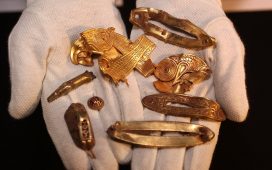Archaeologists digging under the Church of the Holy Sepulchre in Jerusalem have found signs of an ancient garden that align with biblical descriptions.
Many Christians believe the church is where Jesus was buried and it continues to be a major pilgrimage site.
Now, the discovery of 2,000 year-old olive trees and grapevines are believed to reflect accounts in the Gospel of John of where Jesus was crucified and laid to rest.
“Now in the place where he was crucified there was a garden, and in the garden a new tomb in which no one had yet been laid,” the Gospel of John states.
“The archaeobotanical findings have been especially interesting for us, in light of what is mentioned in the Gospel of John, whose information is considered written or collected by someone familiar with Jerusalem at the time,” Professor Francesca Romana Stasolla told the Times of Israel.
“The Gospel mentions a green area between the Calvary and the tomb, and we identified these cultivated fields.”
Excavations have since been as the churches expect crowds of pilgrims over Easter celebrations.

The 2022 project marked the first major restoration since the 19th century and was headed by a Sapienza University of Rome professor.
The restoration had to be agreed on by the Roman Catholic, Armenian and Greek Orthodox custodians. It also needed an Israel Antiquities Authority licence.
“With the renovation works, the religious communities decided to also allow archaeological excavations under the floor,” Professor Stasolla said.
The team found layers dating from the Iron Age under the basilica, including pottery, oil lamps and soil samples.
The presence of pre-Christian artefacts suggests the land changed over time from a quarry, through cultivated land to a burial site over time.










